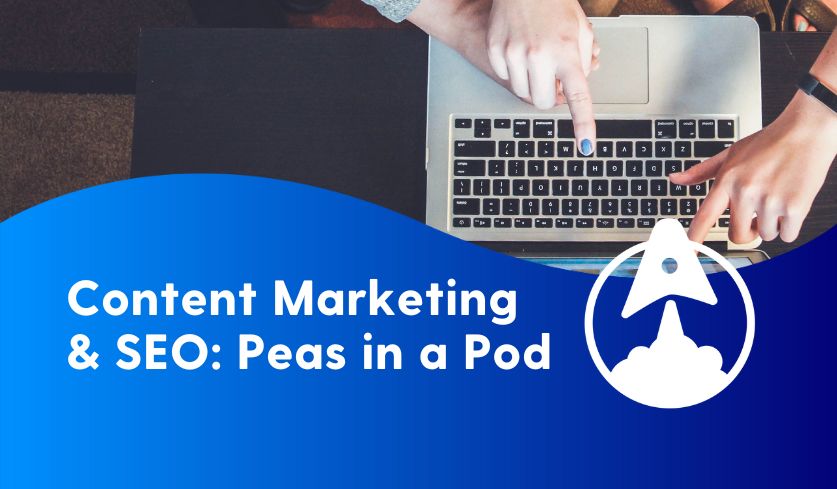Fewer marketing strategies go together as naturally as content marketing and SEO. Like peanut butter and jelly or peas and carrots, content marketing and SEO are a classic pairing for a reason. These two work symbiotically: Content marketing improves SEO, and SEO enhances the success of a content marketing strategy.
In this guide, we’ll explain some of the essential components of content marketing in SEO. We’ll also offer some of our favorite tips for ensuring these two seemingly separate elements enmesh seamlessly.
But first things first…
What is content marketing?
Content marketing encompasses a suite of materials created and promoted for the purpose of raising awareness, attracting leads, or converting customers. It’s done to intrigue others into learning more about what you offer — it’s not entirely or solely promotional.
Content marketing can refer to any content created with this intention, including videos and social media posts. However, for this blog’s purposes, we’ll discuss content marketing within the framework of blogs and website pages.
What is SEO?
Short for “search engine optimization,” SEO is the process of optimizing a website for it to rank higher on search engine results pages (SERPs). In SEO, you strive to rank higher specifically for search terms relevant to your brand or business.
There are dozens upon dozens of factors that influence how your website performs on search engines. Content marketing is among those you can optimize for your website’s benefit.
What are some of the essential elements of content marketing in SEO?
When creating content strategies for SEO, the below factors drive their purpose.
Quality content
Quality, quality, quality. You’re going to hear that word a lot in this blog (and throughout The Stellastra Effect website), and there’s a reason for that. Quality matters, and it isn’t easy to achieve. In fact, quality matters for a lot of reasons, including the below.
- It establishes the authority of both your site and your brand
- It offers valuable information your target audience wants to read
- It can outperform websites that don’t publish quality content
- It contributes to higher conversion rates — better content, more leads, and more customers!
Keywords
Thinking about what your customers are searching for online helps establish what your content marketing strategy should be. This is one of the most obvious ways content marketing and SEO come together.
You shouldn’t write content about just any keywords — it’s all about targeting search terms that match what your customers actually want and need. They may be searching for a specific piece of information, hoping to learn something new, or aiming to make a purchase. All three cases influence which keywords you select and write about. The more accurate your list of keywords, the more efficient (and successful) your SEO and content marketing efforts.
Backlinking
A backlink is when another webpage links to yours. The more important these websites are — and the more relevant to your niche — the more your website earns top rankings in search results. Backlinking is a vital off-page SEO strategy, meaning that, although backlinking occurs on other websites, it factors into how your website performs.
Creating and distributing quality, relevant content is one of the best ways to earn backlinks. The theory behind this strategy is that data-dense, interesting content naturally makes its way into other articles. A backlink from that article to your content serves as an attribution of sorts to your information. In this regard, an investment into content marketing for SEO truly pays off in more ways than one!
“Shareability” factor
The content produced for your SEO strategy should be so good that it basically promotes itself! What do we mean by that? Well, it should offer something that encourages others to share your content on social media or forward it to their friends via email. These actions have a practical effect on amplifying reach since they introduce people outside your circle to your content. It also serves as a signal to search engines, which take this as a vote of confidence in the content being shared. After all, content helpfulness will always be one of the leading factors in ranking.
How content marketing and SEO work together
SEO and content shouldn’t be separated. Here’s how these two crucial components work together for a successful strategy.
Content marketing drives website traffic — which is good for SEO
Content marketing work results in ample reasons for people to visit your website. You can use your content to share fresh news, interesting information, promotional deals, lifestyle features, and so much more. No wonder producing content for marketing purposes brings visitors to your door and encourages them to stay a while.
Each piece of content in and of itself is essential to bringing visitors into the fold in the first place. Intriguing, educational, and informative content signals to readers that you’re an authority on the subject in question. And search engine algorithms pick up that authority as well.
SEO needs good content to perform at its best
There are many, many factors that affect your site’s ability to rank in search engines. And although content might not be the whole picture, it’s a significant part of it. On top of that, for many business owners and marketers, content is an easy place to go wrong. We get it — maybe you’re not a writer, maybe you hate writing, or maybe you don’t have any writers on your team. But we’re here to say it loud and say it clear: Not investing in quality writing can sideline your SEO and content marketing strategies.
Content marketing improves the user experience, which is also good for SEO
Imagine this: You’re scrolling on LinkedIn on your phone when you stumble upon a really interesting article. You tap it and wait a few seconds for it to load, only to “X” out two popups and struggle with tiny, improperly-formatted text. If you’re like most internet users, you’re going to leave that page, article content be damned. What we just described here is a bad user experience (UX). This term refers to how easy it is for someone to use a website (or app, or similar digital product).
Design plays a key role in attracting people to a site and keeping them around. If your target audience can easily get the information they need or take the action they want, they’re more likely to finish that action. When site design is bad, on the other hand, people leave the site. And when people leave a site, it increases that site’s bounce rate, or how many people leave a website without visiting any other pages. A high bounce rate is a signal to search engines that your site may not be all it’s cracked up to be.
The quality of the content itself matters here, too. Content that’s poorly written, inaccurate, or overly promotional runs the risk of alienating visitors and contributes to a bad user experience. Good content offers site visitors pretty much the information they’re looking for, and that’s important. A dissatisfied visitor will leave and might never come back.
When posting content, work with your site designer or developer to make sure the content is easy to read and looks great. Use the “preview” function to make sure that the text looks right and that the images and photos fit appropriately. Without these elements in place, you risk nobody reading your content at all.
SEO vs. content marketing
SEO is an all-encompassing practice describing the technical work put into your site to help it rank on search engines. Content marketing refers to a strategy that leverages content to reach customers.
Don’t think of SEO and content marketing as polar opposites, though — far from it! These two marketing strategies are two peas in a pod. Quality SEO relies on content marketing to drive traffic, reach people, and spark their interest in what you have to say (and sell). In turn, content marketing relies on SEO to help get the content in front of more potential customers.
Tips and best practices for content marketing in SEO
- Focus on quality first. From what you write to how it looks on the page, quality gives you a strong upper hand. Sure, you can (and should!) check all the boxes by answering questions thoroughly and offering your unique take. But what’s between the lines — the quality of your brand and company as a whole — is what’s read between the lines.
- Think about user intent. Why is someone searching for a certain keyword? That’s called “searcher intent” or “user intent,” and it should be at the core of your content marketing in SEO strategy. Stay focused on what you think your customers want to learn, know, or find out about your business, and stick with it.
- Plan ahead. Content marketing isn’t a sprint — slow and steady wins this race! Create an editorial calendar that you know you can stick to, even if you’re only writing a few blogs a month. It’s better to build a content marketing plan, create a habit, and stick with it than to blog a bunch, stop, and continue again later.
- Don’t forget about SEO while you focus on content marketing. As we’ve established here, SEO and content marketing are a yin and yang of sorts. But content marketing isn’t the only component that pushes your site toward the top of SERPs. You also have to consider your site’s technical factors, design, and other elements that don’t have much to do with writing. Be sure to have a plan for that, too.
Let The Stellastra Effect handle your content marketing for SEO
Just as successful content marketing needs SEO to thrive, good SEO needs high-quality content to thrive. The Stellastra Effect unites the writing skills of award-winning former journalists with the latest SEO best practices to power your content marketing strategy. With us on your side, you’ll get all the momentum you need to truly succeed online.
Need help getting your content marketing off the ground? Reach out to our SEO writing agency, and we’ll do the heavy lifting for you. It’s the least effort you’ll ever put into climbing all the way to the top.







